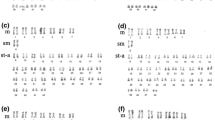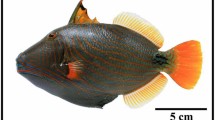Abstract
Highly repetitive DNA of C0t 0–0.2 was purified from whole DNA of Triturus cristatus carnifex, labelled by nick translation, and in situ hybridized to RNA transcripts on the loops of lampbrush chromosomes and to the DNA of mitotic chromosomes from intestinal epithelium from the same species. The labelled DNA bound to 20–30 loops on the long arms of lampbrush bivalent 1, a pair of loops near the centromere on bivalent 10, and a number of other loops most of which were localized in pericentric regions. In mitotic preparations the same labelled DNA bound to the heteromorphic regions of the long arms of both chromosomes 1, and to the centromeric regions of all chromosomes. Centromeric labelling was light on chromosomes 4 and particularly clear on the 3 shortest chromosomes of the set. The heavy labelling of the heteromorphic arms of chromosome 1 is discussed in relation to several other peculiar properties of these arms, including their extraordinary lengths, their Giemsa banding patterns, and the absence of meiotic crossing over. It is suggested that insofar as the results with DNA/DNA hybridization and mitotic chromosomes match those obtained with the DNA/RNA-transcript hybridization and lampbrush chromosomes, confidence in the latter technique may be increased accordingly.
Similar content being viewed by others
References
Callan, H.G., Lloyd, L.: Lampbrush chromosomes of crested newts Triturus cristatus (Laurenti). Phil. Trans. roy. Soc., Lond., 243B, 135–219 (1960a)
Callan, H.G., Lloyd, L.: Lampbrush chromosomes. In: New approaches in cell biology (P.M.B. Walker, ed.), p. 24–36. New York: Academic Press 1960b
Callan, H.G., Lloyd, L.: Working maps of the lampbrush chromosomes of Amphibia. In: Handbook of genetics, Vol. 4 (R.C. King, ed.), p. 57–77. New York: Plenum Publishing Corporation 1975
Gall, J.G.: Lampbrush chromosomes from oocyte nuclei of the newt. J. Morph. 94, 283–351 (1954)
Macgregor, H.C.: Trends in the evolution of very large chromosomes. Phil. Trans. roy. Soc., Lond. B, 283, 309–318 (1978)
Macgregor, H.C., Andrews, Christine: The arrangement and expression of “middle repetitive” DNA sequences on lampbrush chromosomes of Triturus. Chromosoma (Berl.) 63, 109–126 (1977)
Macgregor, H.C., Mizuno, S.: In situ hybridization of “nick-translated” 3H-ribosomal DNA to chromosomes from salamanders. Chromosoma (Berl.) 54, 15–25 (1976)
Mancino, G., Ragghianti, M., Bucci-Innocenti, S.: Cytotaxonomy and cytogenetics in European newt species. In: The reproductive biology of amphibians (D.H. Taylor and S.I. Guttman, eds.), p. 411–447. New York: Plenum Publishing Corporation 1977
Morgan, G.T.: Absence of chiasmata from the heteromorphic region of chromosome 1 during spermatogenesis in Triturus cristatus carnifex. Chromosoma (Berl.) 66, 269–280 (1978)
Pukkila, P.J.: Identification of the lampbrush chromosome loops which transcribe 5S ribosomal RNA in Notophthalmus (Triturus) viridescens. Chromosoma (Berl.) 53, 71–89 (1975)
Rudak, E., Callan, H.G.: Differential staining and chromatin packing of the mitotic chromosomes of the newt Triturus cristatus. Chromosoma (Berl.) 56, 349–362 (1976)
Author information
Authors and Affiliations
Rights and permissions
About this article
Cite this article
Macgregor, H.C. In situ hybridization of highly repetitive DNA to chromosomes of Triturus cristatus . Chromosoma 71, 57–64 (1979). https://doi.org/10.1007/BF00426366
Received:
Issue Date:
DOI: https://doi.org/10.1007/BF00426366




